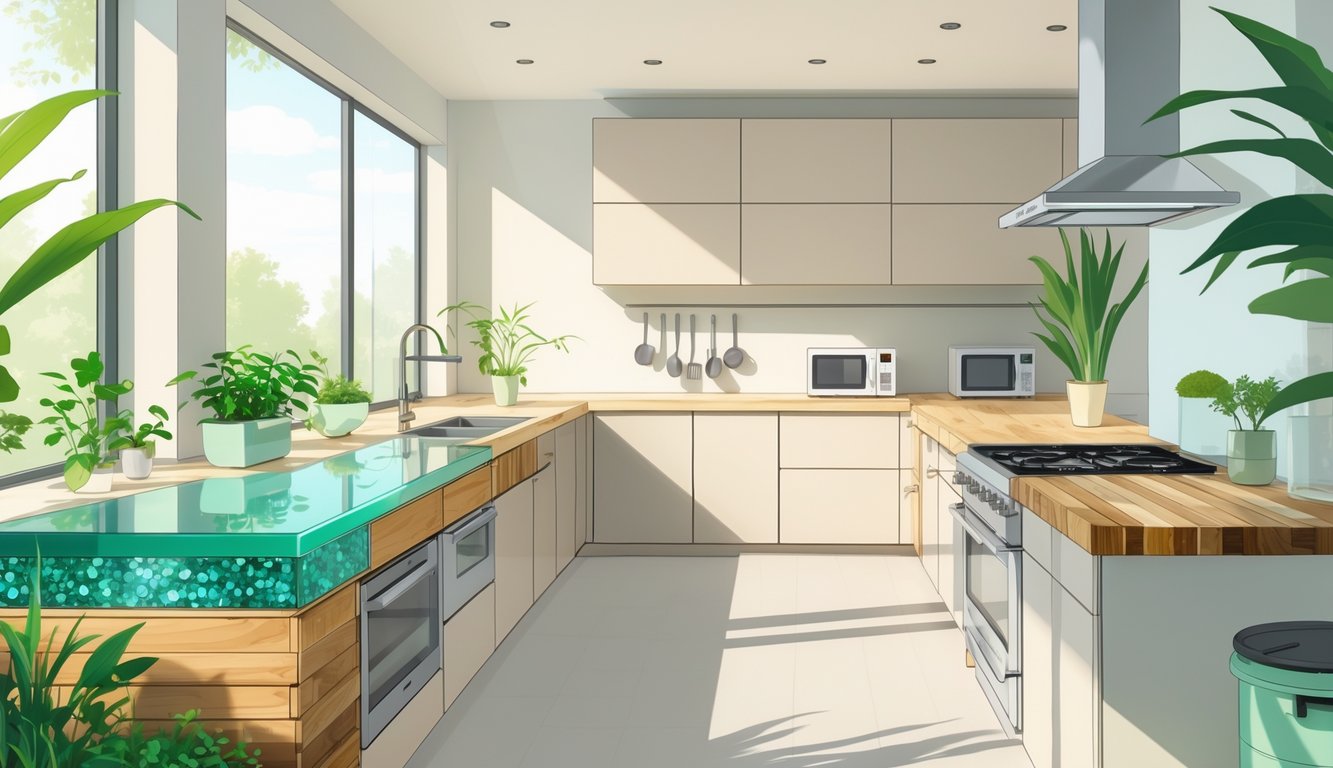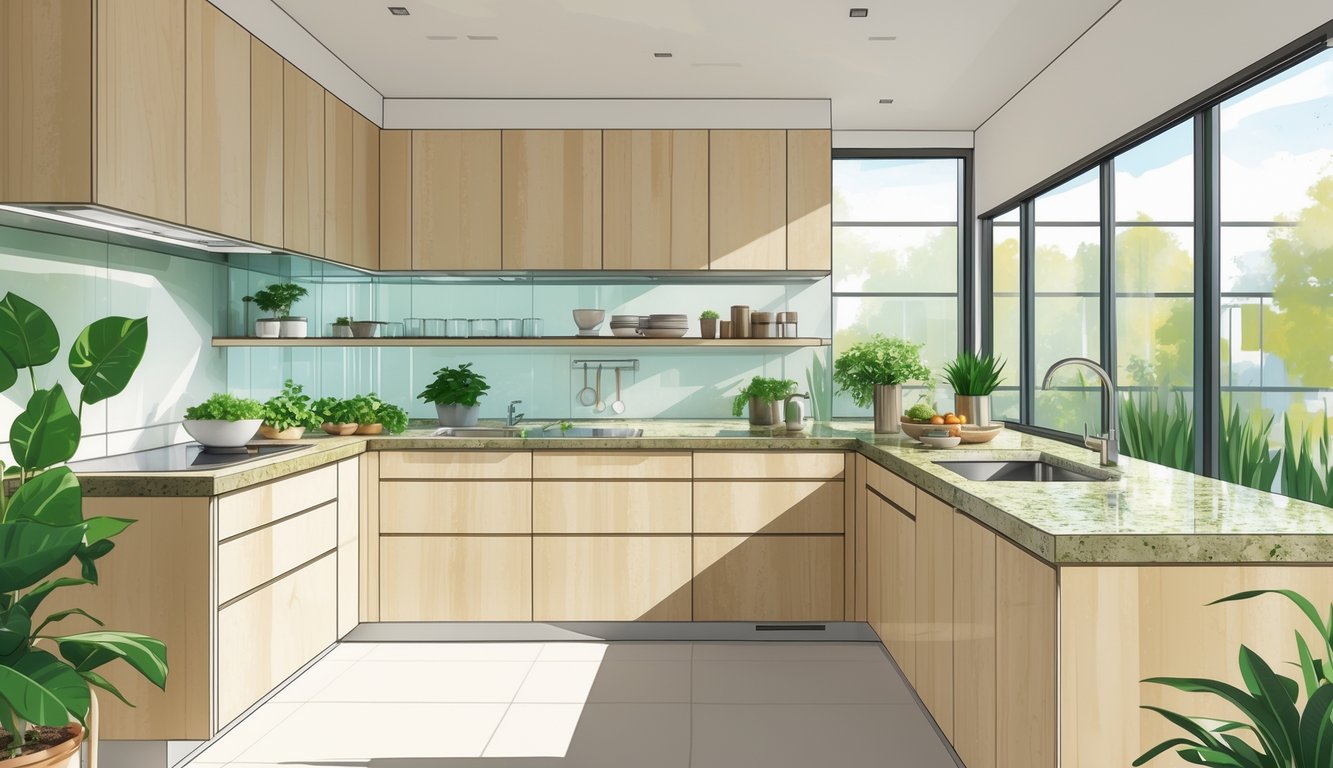
Aesthetic Appeal and Kitchen Design Integration

Honestly, who’s picking these colors? Every time I walk into a showroom, I swear the “eco” options look like they’re stuck in 2009. Supposedly, “eco-conscious kitchens” are everywhere now, but most people just poke at recycled glass and quartz, hoping for something that doesn’t look like a science experiment. And why does nobody mention how some countertops get weirdly hot under those LED strips? Am I the only one sweating over grout lines and heat shimmer?
Color and Texture Options
Try arguing with a kitchen designer about quartz colors. It’s like they’re on commission for “Misty Carrera” or whatever Caesarstone is pushing this week. Infinite tones, they say, but then you get matte white or “greige” (which, sorry, isn’t a color). Texture? Everyone wants “not hospital,” but also “not too rustic.” Recycled glass ends up looking like a disco floor, bamboo screams “juice bar,” and porcelain is so smooth it feels fake.
Wildest part? Quartz pretends to be marble but doesn’t need sealing. Stone guys roll their eyes at etch marks. And if you want easy-clean, Viatera’s Dolce gets pushed as the no-fuss option—unless you’re that neighbor who scratches everything. (You know who you are.)
Rustic Charm with Reclaimed Materials
Reclaimed wood: all the rage, but nobody tells you about the splinters. You get nail heads, weird stains, and everyone at your party wants to touch the “gash by the toaster.” Market dudes pitch “salvaged oak” like it grows on trees, but try finding it when you actually need it. Last three times I called? “Sold out.” Texture’s great, but so is tetanus, apparently.
Here’s what nobody warns you about: humidity makes these tops groan and creak like haunted floorboards. Water rings? Permanent. But if you want character, old soapstone or battered stone slabs have this lived-in, “I don’t care if it matches” vibe. Atlanta Stone Creations shouts about nontoxic finishes, but my dog chews the corners anyway. Still, nothing feels more honest than a countertop with a stubborn, uneven edge.
Modern Designs with Sustainable Choices
Ever tried to seam recycled paper composite? I dare you. Every cut edge looks like a science project gone wrong. But if you want that “magazine minimalist” look, these surfaces are everywhere. Porcelain slabs? They’re sneaking into eco-friendly kitchen renos, even though every installer I’ve met groans about their weight. Concrete? You can pigment it any color, but it’ll crack by year two, guaranteed. Modern, but flawed.
Designers keep dropping “sintered stone” like it’s the next big thing. Nobody in my zip code has even heard of it, but every blog calls it “luxury.” The cool kids? They mix materials—glass-chip waterfall islands with boring bamboo for prep. LX Hausys says it’s about survival, not just looks; honestly, if your countertop survives coffee spills and teens with butter knives, you win.
Sustainable Options for Kitchen and Bathroom Renovation
Granite? I watched it crack and learned why everyone’s obsessed with renewables. Even if you just eat cereal over the sink, air quality sneaks up on you. Bathroom? Forget it. Humidity kills half the options, the rest is marketing. I made a spreadsheet. My brother mocked me.
Selecting for Kitchen Renovation Projects
Bamboo—why does it haunt me? If you’ve seen the bamboo countertop hype, it’s not just for influencers. My contractor rolled his eyes but admitted bamboo grows up in three to five years. Rapid renewability. But spill red wine before sealing? Tragedy. I wiped mine for so long I missed half of Bake Off. Recycled glass counters? Beautiful, but at $65–$250 a square foot installed (I checked Granite Selection), it’s a punch to the gut.
Quartz? Supposed to be stain-resistant, $60–$150 per square foot, but lemon juice will still ruin your day. Recycled paper composite? If you forget to seal it, it warps. Ask me how I know. Never again.
Choosing for Bathroom Upgrades
Humidity makes “eco-friendly” stuff curl up like potato chips. My recycled wood counter? Warped corners forever. Plumber’s assistant mentioned VOCs in laminate, so now I check everything. Sustainable bathroom materials actually help air quality, but you’ll need to air out the room for days. Nobody tells you that.
Concrete scared me. Drop a shampoo bottle and I’m convinced it’ll crack. But it’s tough, recyclable, and if sealed, survives. Vetrazzo (used it in a guest bath) looks wild—guests thought it was terrazzo. Recycled glass and porcelain? Barely flinch at steam, but you’ll pay for it, and if your installer messes up, the edges chip every time you drop your hairbrush.
My spreadsheet says: skip salvaged stone in humid rooms unless you love mildew. Cork or reclaimed wood? Mold magnets. No renovation blog admits it. EPA says low-emission adhesives are the real deal, not just “green” stone.
Certifications, Standards, and Sustainable Living
I got lost in eco-labels—so many abbreviations, colors, and stickers slapped on boxes. Wrong logo? Whole project feels off. You can spend a fortune on “sustainable” gear and wind up with something that barely counts.
Understanding LEED and Other Certifications
LEED. Everyone acts like it’s a golden ticket—“Leadership in Energy and Environmental Design” gets you instant eco-cred, but the paperwork? Nightmare. One countertop won’t score you points; it’s about the whole project, supply chain, energy, blah blah. Saw a 2023 fact sheet—86,000+ projects use LEED. That’s… a lot.
GREENGUARD means someone tested emissions, FSC means wood isn’t from a disaster zone. VOCs? They’re everywhere. GREENGUARD-certified means less off-gassing, maybe fewer headaches. Some guy at a kitchen expo told me, “No placebos.” Stuck in my head. And honestly, shipping stone across the world for a “sustainable” label? Feels like cheating.
How to Verify Eco-Conscious Claims
Big-box store guy once told me a random “eco” label meant I was set. I asked for proof, got a blank stare. You want legit? Find actual third-party certification, audit trails, something you can Google. Still not foolproof. Sustainable countertop brands sometimes link to cert agencies or show batch numbers. That’s a good sign.
Red flags: generic “green” logos, no standard, no info on raw materials. If a company can’t cough up LEED docs or VOC breakdowns, bail. I saw a laminate sample stamped “eco” with zero info on resin or recyclability. Transparency isn’t a flex—it’s basic. Dig into the details, cross-check batch numbers, maybe even call the cert body yourself. Recycled content? Don’t just trust the label. For real sustainable living, nothing beats awkward questions and a little paperwork.